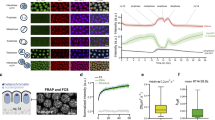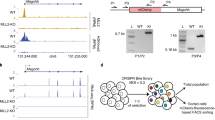Abstract
To maintain phenotypes of cell lineages, cells must 'remember' which genes were active before mitosis entry and transmit this information to their daughter cells so that expression patterns can be faithfully re-established in G1. This phenomenon is called gene bookmarking. However, during mitosis transcription ceases, most sequence-specific proteins dissociate from DNA and the chromatin is tightly compacted, making it difficult to understand how gene activity 'memory' is maintained through this stage of the cell cycle1,2. A feature of gene bookmarking is that in mitotic cells, the promoters of formerly active genes lack compaction, but how compaction of these regions is inhibited is unknown3,4. Here we show that during mitosis, TATA-binding protein (TBP), which remains bound to DNA during mitosis, recruits PP2A. TBP also interacts with condensin to allow efficient dephosphorylation and inactivation of condensin near these promoters to inhibit their compaction. Further, ChIP-on-chip data show that TBP is bound to many chromosomal sites during mitosis, and is higher in transcribed regions but low in regions containing pseudogenes and genes whose expression is tissue-restricted. These results suggest that TBP is involved not only in gene transcription during interphase but also in preserving the memory of gene activity through mitosis to daughter cells.
This is a preview of subscription content, access via your institution
Access options
Subscribe to this journal
Receive 12 print issues and online access
$209.00 per year
only $17.42 per issue
Buy this article
- Purchase on Springer Link
- Instant access to full article PDF
Prices may be subject to local taxes which are calculated during checkout





Similar content being viewed by others
Accession codes
References
Gottesfeld, J. M. & Forbes, D. J. Mitotic repression of the transcriptional machinery. Trends Biochem. Sci. 22, 197–202 (1997).
Hirano T. At the heart of the chromosome: SMC proteins in action. Nature Rev. Mol. Cell. Biol. 7, 311–322 (2006).
Larsen, A. & Weintraub, H. An altered DNA conformation detected by S1 nuclease occurs at specific regions in active chick globin chromatin. Cell 29, 609–622 (1982).
Michelotti, E. F., Sanford, S. & Levens, D. Marking of active genes on mitotic chromosomes. Nature 388, 895–899 (1997).
John, S. & Workman, J. L. Bookmarking genes for activation in condensed mitotic chromosomes. Bioessays 20, 275–279 (1998).
Sarge, K. D. & Park-Sarge, O. K. Gene bookmarking: keeping the pages open. Trends Biochem. Sci. 30, 605–610 (2005).
Segil, N., Guermah, M., Hoffmann, A., Roeder, R. G. & Heintz, N. Mitotic regulation of TFIID: inhibition of activator-dependent transcription and changes in subcellular localization. Genes Dev. 10, 2389–2400 (1996).
Christova, R. & Oelgeschlager, T. Association of human TFIID-promoter complexes with silenced mitotic chromatin in vivo. Nature Cell. Biol. 4, 79–82 (2002).
Chen, D., Hinkley, C. S., Henry, R. W. & Huang, S. TBP dynamics in living human cells: constitutive association of TBP with mitotic chromosomes. Mol. Biol. Cell 13, 276–284 (2002).
Xing, H. et al. Mechanism of hsp70i bookmarking. Science 307, 421–423 (2005).
Hirano, T., Kobayashi, R. & Hirano, M. Condensins, chromosome condensation protein complexes containing XCAP-C, XCAP-E and a Xenopus homolog of the Drosophila Barren protein. Cell 89, 511–521 (1997).
Gulledge, B. M., Aggen, J. B., Huang, H. B., Nairn, A. C. & Chamberlin, A. R. The microcystins and nodularins: cyclic polypeptide inhibitors of PP1 and PP2A. Curr. Med. Chem. 9, 1991–2003 (2002).
Kloeker, S. et al. Parallel purification of three catalytic subunits of the protein serine/threonine phosphatase 2A family (PP2A(C), PP4(C), and PP6(C)) and analysis of the interaction of PP2A(C) with α4 protein. Protein Expr. Purif. 31, 19–33 (2003).
Takemoto, A., Kimura, K., Yokoyama, S. & Hanaoka, F. Cell cycle-dependent phosphorylation, nuclear localization, and activation of human condensin. J. Biol. Chem. 279, 4551–4559 (2004).
Kimura, K. & Hirano, T. ATP-dependent positive supercoiling of DNA by 13S condensin: a biochemical implication for chromosome condensation. Cell 90, 625–634 (1997).
Fairley, J. A., Scott, P. H., & White, R. J. TFIIIB is phosphorylated, disrupted and selectively released from tRNA promoters during mitosis in vivo. EMBO J. 22, 5841–5850 (2003).
Favre, B., Turowski, P., & Hemmings, B. A. Differential inhibition and posttranslational modification of protein phosphatase 1 and 2A in MCF7 cells treated with calyculin-A, okadaic acid, and tautomycin. J. Biol. Chem. 272, 13856–13863 (1997).
Honkanen, R. E., & Golden, T. Regulators of serine/threonine protein phosphatases at the dawn of a clinical era? Curr. Med. Chem. 9, 2055–2075 (2002).
Denissov, S., et al. Identification of novel functional TBP-binding sites and general factor repertoires. EMBO J. 26, 944–954 (2007).
Isogai, Y., Keles, S., Prestel, M., Hochheimer, A., & Tjian, R. Transcription of histone gene cluster by differential core-promoter factors. Genes Dev. 21, 2936–2949 (2007).
Hernandez, N. TBP, a universal eukaryotic transcription factor? Genes Dev. 7, 1291–1308 (1993).
Hochheimer, A. & Tjian, R. Diversified transcription initiation complexes expand promoter selectivity and tissue-specific gene expression. Genes Dev. 17, 1309–1320 (2003).
Armstrong, L., Lako, M, Dean, W. & Stojkovic, M. Epigenetic Modification is Central to Genome Reprogramming in Somatic Cell Nuclear Transfer. Stem Cells 24, 805–814 (2006).
Morgan, H. D., Santos, F., Green, K., Dean, W. & Reik, W. Epigenetic reprogramming in mammals. Hum. Mol. Genet. 14, R47–58 (2005).
Allegrucci, C., Denning, C., Priddle, H. & Young, L. Stem-cell consequences of embryo epigenetic defects. Lancet 364, 206–208 (2004).
Schubart, D. B. et al. Gene structure and characterization of the murine homologue of the B cell-specific transcriptional coactivator OBF-1. Nucleic Acids Res. 24, 1913–1920 (1996).
Yan, J., Xu, L., Crawford, G., Wang, Z., & Burgess, S. M. The forkhead transcription factor foxI1 remains bound to condensed mitotic chromosomes and stably remodels chromatin structure. Mol. and Cell. Biol. 26, 155–168 (2006).
Acknowledgements
We are very grateful to Sui Huang and Arnold Berk for their generous gifts of GFP–TBP and GST–TBP plasmids, respectively, and to lab members for insightful discussions. This research was supported by NIH grants to K.D.S. (GM61053 and GM64606).
Author information
Authors and Affiliations
Contributions
The study was directed and funded by K.D.S.; N.L.V performed the in vitro binding experiments between GST–TBP and in vitro translated CAP-G; H.X. performed all other experiments and K.D.S. wrote the paper.
Corresponding author
Ethics declarations
Competing interests
The authors declare no competing financial interests.
Supplementary information
Supplementary Information
Supplementary Information (PDF 1883 kb)
Rights and permissions
About this article
Cite this article
Xing, H., Vanderford, N. & Sarge, K. The TBP–PP2A mitotic complex bookmarks genes by preventing condensin action. Nat Cell Biol 10, 1318–1323 (2008). https://doi.org/10.1038/ncb1790
Received:
Accepted:
Published:
Issue Date:
DOI: https://doi.org/10.1038/ncb1790
This article is cited by
-
A changing paradigm of transcriptional memory propagation through mitosis
Nature Reviews Molecular Cell Biology (2019)
-
Condensin action and compaction
Current Genetics (2019)
-
The loading of condensin in the context of chromatin
Current Genetics (2017)
-
Mitotic binding of Esrrb marks key regulatory regions of the pluripotency network
Nature Cell Biology (2016)
-
Mitotic Bookmarking: Maintaining Post-Mitotic Reprogramming of Transcription Reactivation
Current Molecular Biology Reports (2016)



